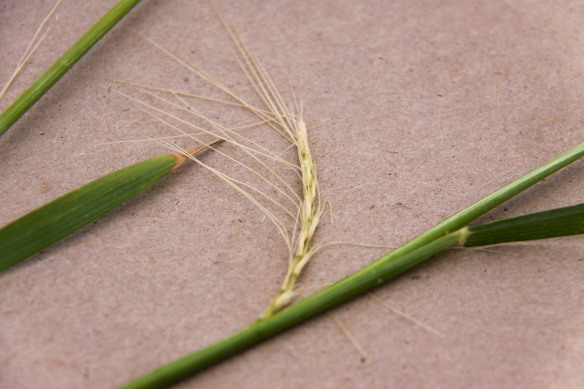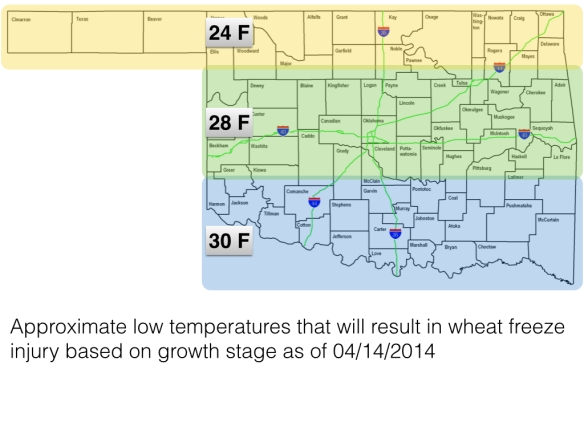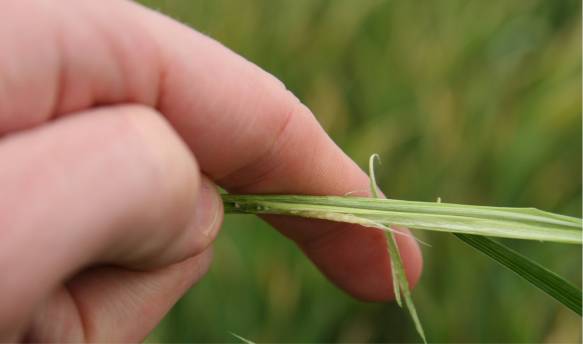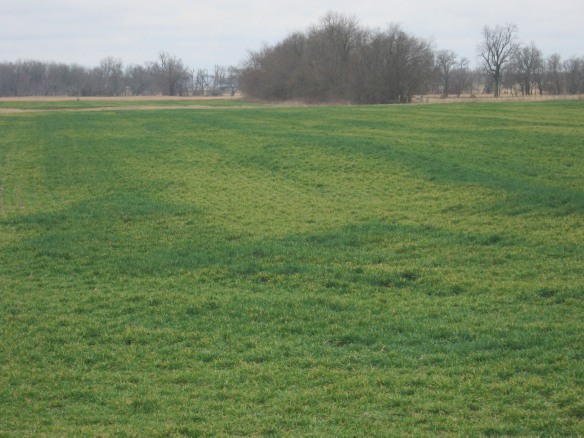Wheat disease updates are written by Dr. Bob Hunger, OSU Extension Plant Pathologist
Oklahoma: Wheat around Stillwater is mostly at GS 10.2 to 10.4 (heads ¼ to ½ emerged from boot). Conditions are still dry, not only around Stillwater, but also around much (if not all) of the state. Some rain fell this past week in the 1 inch range in a few areas, but in southwestern OK it was most likely too late to help the wheat. Freeze damage also is becoming much more apparent.
Dr. Jeff Edwards (OkSU Small Grains Exten Spec) and I looked at wheat and attended a field day yesterday evening near Apache, OK (about 75 miles southwest of Oklahoma City). The variety trial and field at Apache was lost because of freeze. Wheat at Dr. Edward’s trial at Chickasha (30 miles northeast of Apache) also had some freeze damage but not as severe as the wheat around Apache. No foliar diseases were seen at any field at which we stopped, and no reports of foliar diseases have come to me since my last update (10-Apr). As you can tell from the reports below from Texas, there just is not much inoculum south of us to be carried northward, and what does blow up is likely not finding an environment conducive to infecting.
Our diagnostic lab has received few samples. Of two recent samples from Garfield County (north-central OK), one was positive for Wheat streak mosaic virus (WSMV) and the other was positive for WSMV and High plains virus. The diseases caused by these viruses, which are transmitted by the wheat curl mite, were fairly widespread in Oklahoma in 2013 and probably will be again in 2014. However, I suspect that the drought and freeze will mask these infections.
Reports/excerpts of reports from other states:
Texas Dr. Ron French (Ast Prof, Extn Plant Pathologist, Texas A&M AgriLife Extn Service) 25-Apr-2014: Was driving all day and night (600 miles) yesterday looking at crops from Castroville to the Lower Rio Grande Valley and back. Today heading back to Amarillo. Last Tuesday April 15 I drove from Amarillo to Wichita Falls (Northern Central part of the state right along the Oklahoma border) and back to Amarillo (220 miles NW of Wichita Falls). Looked at commercial wheat and some trial plots in Chillicothe.
Did not see any rust at all and brought samples back just to make sure. In the Wichita Falls area, wheat was at Feekes 10.4 (3/4 fully headed) on average. So now they should be at least flowering. In the Chillicothe area (65 miles NW of Wichita Falls towards Amarillo) wheat was on average at Feekes 10.3 (heading half complete). Have not heard of any rust in this area (Rolling Plains and Panhandle) this week.
I have not received any feedback of stripe rust moving north of Ellis County (from my April 10 report), although now it is also in Hill County, adjacent to Ellis, but in a SW direction. In Hill County, wheat with stripe rust was past pollination and into grain fill. Even in Bell county (Temple area, 120 miles south/southeast of Dallas) there was trace levels of stripe rust and none in the flag leaf. Except for the Texas Panhandle, all other areas will soon (early next week for the Vernon area) be out of the window for spraying any fungicides.
So the good news is that rust is not moving north, yet. With warm temperatures during the day but cool at night, this might be affecting continuous fungal growth for both stripe and leaf rust fungi.
Texas (from a report issued by Dr. Erick DeWolf at KSU 25-Apr-2014: Texas has reported some stripe rust activity just south of Dallas but warm temperatures have slowed the progress of that disease. Bob Bowden, USDA Plant Pathologist, reports that leaf rust remains active in research plots near San Antonio, Texas. However, the disease remains at low levels in commercial fields according to Tom Isakeit, Extension Plant Pathologist for Texas A&M. Wheat fields in southern Texas are nearly ready for harvest.
Kansas Dr. Erick DeWolf, Extension Wheat Pathologist, Kansas State University 24-Apr-2014: The risk of severe leaf diseases remains low throughout Kansas. My own scouting and reports from K-State agronomists indicate that leaf rust and stripe rust are not present in the state. Tan spot, septoria leaf blotch, and powdery mildew were absent in most fields; however, we did find a small number of fields with low levels of tan spot in Saline, McPherson, and Sedgwick counties. These fields all had wheat residue from previous crops on the soil surface. This residue is important because it often harbors the fungus that causes tan spot.
Drought stress was evident in most fields and the dry conditions are holding disease in check for now. Recent rains have brought some temporary relief to the dry conditions in a few areas of the state. We will continue monitoring the disease situation as this moisture may stimulate some disease. The symptoms of any new infections would not become evident for 7-10 days. The current risk of severe disease in Kansas and the need for foliar fungicides is low.




















